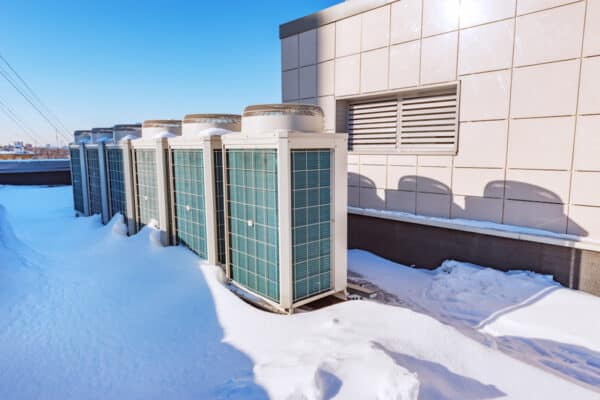VRF Working Principle (Air-cooled & Water-cooled)
What is VRF system and how does it works? How about VRV system? What is the difference? VRF system can be complicated but, here is the ultimate explanation of what is VRF system.
Firstly, what is VRF system? VRF or variable refrigerant flow is an air conditioning technology that varies the amount of refrigerant flow into each of its connected indoor unit to achieve precise temperature control and a higher efficiency.
A typical VRF system consist of a single outdoor unit serving multiple indoor units. In a large scale VRF system, there can be multiple outdoor units serving even more indoor units.
The benefits of the VRF system is positioned in between the large capacity chiller and the small capacity split AC. The VRF system provides great flexibility while keeping good energy efficiency. It is an all-around winner when designed properly.
Therefore, designing a VRF system for a new building is very tricky.
Cool Fact: The VRF system is first invented by Daikin back in 1982. It is very common around the world now. It suits many applications due to its design flexibility.
VRF vs VRV: What’s the Difference?
VRV and VRF are essentially referring to the same technology. VRV stands for variable refrigerant volume while VRF stands for variable refrigerant flow. VRV is a trademark name by Daikin. Other manufacturers use VRF to describe the same technology.
VRF System Working Principle
There are two types of VRF systems; air-cooled and water-cooled. The air-cooled VRF system is just like your house air conditioner. It has a blower fan and cooling coil. It uses ambient air to carry away the heat.
On the other hand, the water-cooled VRF system uses water to carry away the heat. It usually connected to cooling towers where the heat dissipates to the surrounding through evaporation.
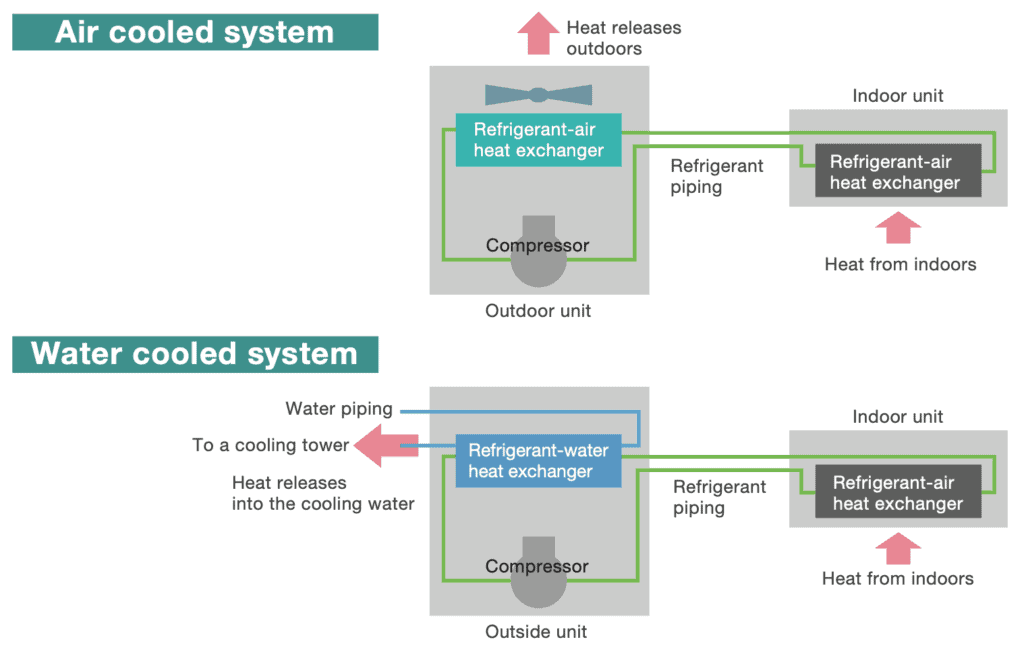
7 Quick Facts about the VRF Air Conditioning System:
- It operates by the principle of the refrigerant cycle just like a typical house air conditioner.
- It uses common refrigerant gas such as the R410A.
- It consists of common AC components such as compressor, fan blower, fan motor, cooling coil, and IC board.
- Its total refrigerant pipe length can be as long as 1,000 meters or over 60 times of a typical single split AC.
- It is an inverter type air conditioner.
- It usually cost more than the conventional single split air AC.
- Its application usually are large houses and commercial buildings.
Outdoor Unit of the VRF System
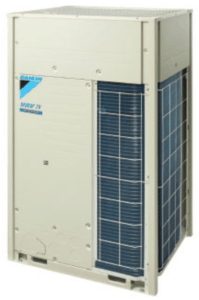
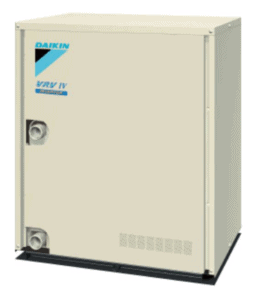

The outdoor unit of the VRF system is very powerful. A single air-cooled VRF outdoor unit can connect up to 64 indoor units. Furthermore, the air-cooled VRF outdoor unit can be placed on the roof while the furthest indoor unit can be as far as 20 floors below it.
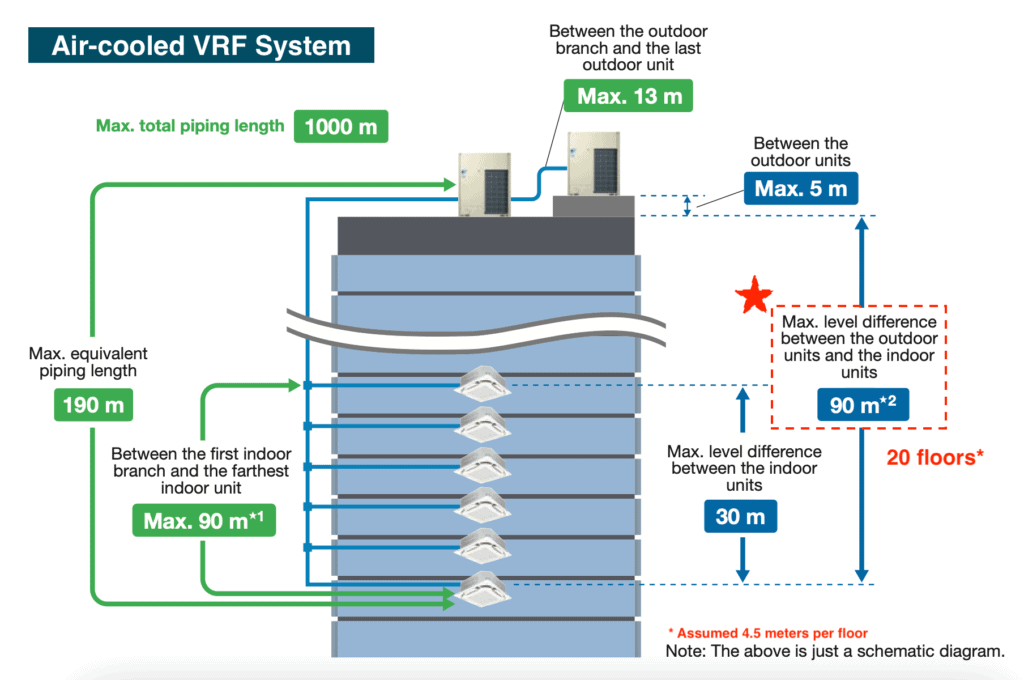
Typical VRF outdoor unit is weatherproof so that they can be placed on the roof or outdoor location exposing to the weather. It is meant to be placed outdoor because it needs ambient air to bring away the heat.
You can think of the air-cooled VRF system like your typical house inverter split air conditioner but just many times larger in cooling capacity.
In the meantime, I would like to inform you that you can learn quicker by getting my HVAC Begin (eBook) if you’re a beginner. But, if you have a year or two of experience, then I would suggest you consider my HVAC Basics (eBook). Nonetheless, I encourage you enroll in my HVAC Beginner Course: 10 Days to Become Competent in HVAC if you want to equipped yourself with a complete set of basic HVAC skills.
HVAC Beginner Course
Learn the most basics and foundational HVAC skills including cooling capacity calculation, equipment selection, duct sizing, pipe sizing, exhaust fan sizing, controls, electrical and more.
4 Things about the Refrigerant Pipe of the VRF System
The refrigerant pipe of the VRF system is very different from the single split system. The copper pipe thickness, insulation thickness, fittings and refrigerant charging are not the same as the single split and multi-split system.
With that said, let’s dive deeper into each core elements of the VRF refrigerant pipe system.
1. VRF System use Special Copper Y-Manifolds
VRF system uses a Y-shape copper manifold to branch out the refrigerant copper pipe. The manifold is a copper pipe fitting that comes in various sizes to match the required copper pipe sizes.
The greater the number of indoor units, the greater the number of the manifold. A typical VRF system could have 10 or 20 or even 30 pieces of such manifold depending on the scale of the system.
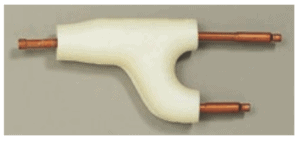
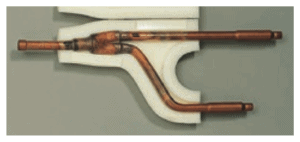
Usually, the manufacturer will select and supply the suitable manifold size or model to you. Wrong manifold sizes will not fit the copper pipe (or need extra fittings) and also disturb the refrigerant flow and affects the performance of the VRF system.
The manifold has to be welded with the copper pipes. Each of the welding points must be well done. If it is not welded completely, there will be holes and the refrigerant gas will leak from there.
On top of that, if it is not welded with sufficient thickness, the high-pressure refrigerant gas will burst out from the thinnest welding point.
Thus, the skill and experience of the welder is extra important when it comes to the VRF system.
2. Copper Pipe and Insulation of the VRF System is Different from the Split System
The copper pipe used for the VRF system is thicker than the usual single split air conditioner because the VRF system operates at a much higher pressure. Hence, the copper pipe must be able to withstand the pressure with room to spare (safety factor).
The single split system typically only uses 1/2″ insulation thickness for both suction and discharge pipe.
But, for the VRF system, we usually go for 1″ insulation thickness at the suction side while maintaining 1/2″ insulation thickness at the discharge side.
3. Refrigerant Charge is Critical in VRF System
The VRF system requires a much greater volume of refrigerant due to its large air conditioner network and long pipe length.
Thus, refrigerant leakage in a VRF system is very costly and time-consuming.
Because the operating pressure of the refrigerant is high, any leakage will result in the depletion of a large volume of refrigerant in a very short amount of time as the high-pressure gas burst out at a very high velocity.
Furthermore, with the large network and long pipe length, the location of the leakage is extremely difficult to identify.
Therefore, the quality of the installation is crucial in a VRF system.
Due to the long pipe length, we have a hard time guessing how much refrigerant is required for the entire system.
Hence, the VRF system manufacturer developed a formula to pre-calculate the estimated amount of refrigerant volume required so that we can prepare for the commissioning of the VRF system. We need to provide the pipe length for each pipe sizes to the manufacturer for the calculation.

Nevertheless, most of the contractors insist to follow gas pressure reading which is suction (gas) 120 psi and discharge (liquid) 300 psi plus minus during commissioning.
But, many manufacturers argued that the ambient air temperature will affect the gas pressure and they insisted to follow their calculated volume or the kilogram (mass) of refrigerant. This is like hands-on vs on-paper.
If you ask me, unless you can provide super accurate pipe length for each pipe sizes, the calculated result will always be an estimation only.
In practical, the pipe length given to the manufacturer will almost always be inaccurate due to many factors such as unrecorded changes, concealed, above ceiling, human error, etc.
Therefore, I will suggest you to still obtain the estimation from the manufacturer, prepare an extra 1 or 2 tong, and check the gas pressure during commissioning.
Tips 1: Perform refrigerant charge during morning and evening to avoid thermal expansion error.
Tips 2: Extra gas can be released but insufficient gas may require a full recharge of the R410A refrigerant.
4. Be Careful with the Pressure Test in VRF System
The pressure test is a very critical step in the installation of the VRF system. It ensures the entire refrigerant pipeline is free from defects or leakages before we operate the VRF air conditioners.
The typical pressure test for a VRF system is suction (gas) 300 psi and discharge (liquid) 500 psi.
Then, the pressure test is passed if there is no pressure drop after it was held for 24 hours. Nitrogen gas is used to pressurize the refrigerant pipe for the pressure test because Nitrogen is an inert gas and it is also relatively cheap.
Precaution: A 18-wheeler lorry tire pressure is about 100 to 120 psi. During pressure test, the VRF refrigerant copper pipe is pressurized to 500 psi. It is 5 times the potential energy of a lorry tire. Hence, always inform all related parties to take care of the pressurized refrigerant pipeline to avoid causing any damage to the pipeline as a dent or two may create a weak spot that allow the high pressure nitrogen to explode out of it. The explosion may shoots out sharp copper pieces that is lethal.
6 Advantages of the VRF System
As I mentioned earlier, the benefits of the VRF system is positioned in between the large capacity chiller and the small capacity split AC.
1. Flexible Design
The outdoor unit of the VRF system can be in multiple modules with a different combination of capacity. At the same time, the associated indoor units also can be in multiple combinations of cooling capacity.
Furthermore, the indoor units can be any type from wall mounted to ceiling cassette to ceiling expose to FCU and AHU. Together, they provide excellent flexibility as we can select the perfect combination to suit each of our applications.
2. High Reliability
The outdoor unit of the VRF system consists of multiple modules and compressors. The compressor is the core component of an air conditioner. A compressor failure will not only cost us money but also gives us long downtime.
A typical VRF system has a built-in smart control that allows it to continue operating by utilizing the other compressor when it detects one or more compressor failure.
In addition, because the outdoor unit of the VRF system is connected in modules, they also can become a backup unit for each other.

Precaution: Although the VRF system continues operation even with one or more outdoor units or compressor failure, do take note that the system will run in an under-capacity state. In another word, not only we are unable to get the desired cooling, all units are loaded at maximum capacity. Therefore, we should get the faulty components repaired as soon as possible to prevent any following breakdown caused by overloading.
3. Space Saving and Aesthetic
Although the outdoor unit of the air-cooled VRF system is much larger in size when compared to the singe split system, the total area or total space occupied by the outdoor unit of the VRF system is actually nearly 4 times lesser than the single split system for a 60HP system.
Moreover, instead of 60 single split outdoor units hanging at the external wall of your building, you can place the VRF outdoor unit on the roof. This enables a much cleaner and aesthetic look for your building.

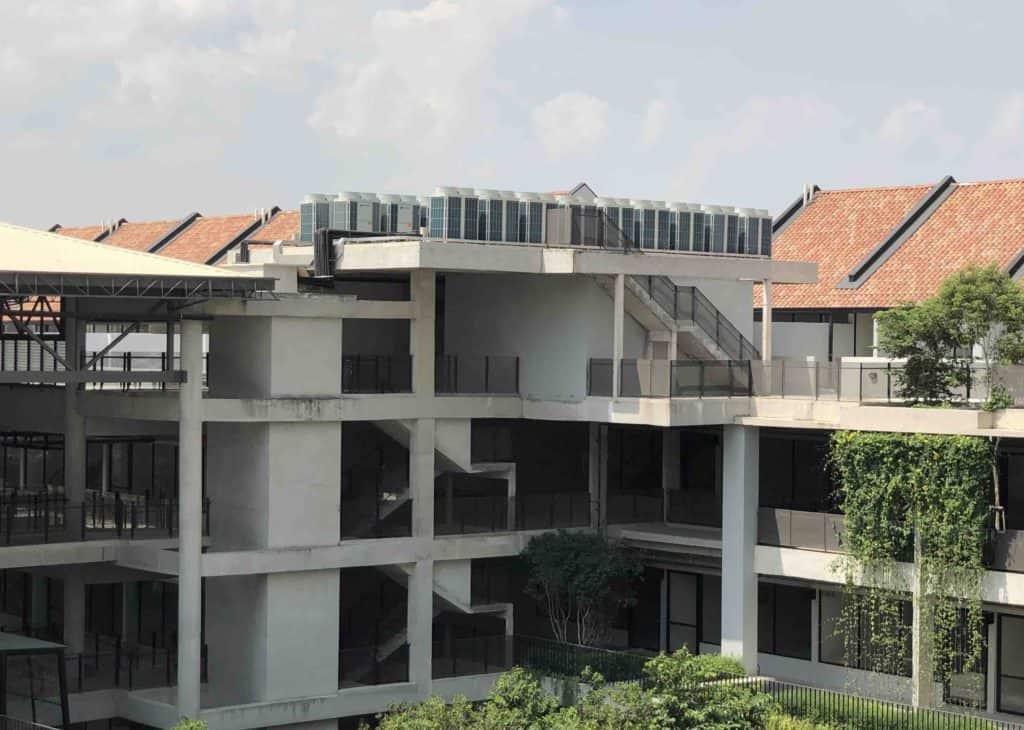
On the other hand, the outdoor unit of the water-cooled VRF is very cool. It typically uses the small-size brazed plate heat exchanger or tube-in-tube heat exchanger rather than the big-size finned tube heat exchanger found in the air-cooled VRF.
Thus, the size of its outdoor unit is almost similar to your typical house air conditioner. The best thing about the water-cooled VRF is that it does not need the ambient air.
This means that it can be placed above the ceiling, in your cabinet or hide somewhere else. Hence, making the water-cooled VRF even more flexible.
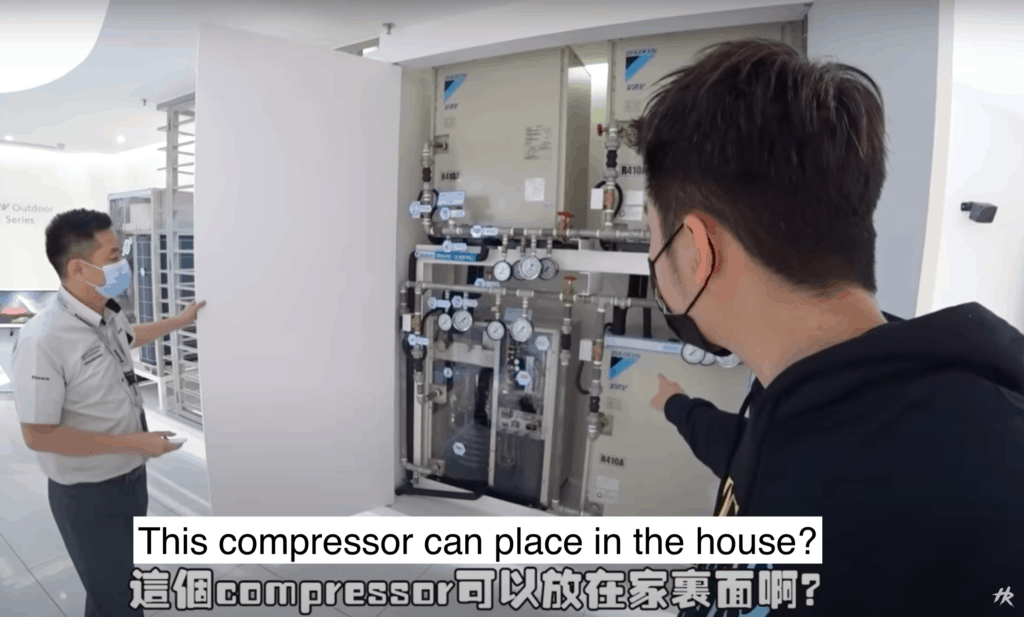
4. Centralized Monitoring and Control
A typical VRF system is equipped with centralized monitoring and control as a standard. The interface protocol usually is either BACnet or MODBUS which are very common here in Malaysia.
Users can monitor and control each and every VRF indoor units from one place; usually at the building management control room together with other mechanical services such as ventilation fan, CCTV, and water pumps.
This gives the operator much better control and enables very fast respond when there is a faulty unit.
Besides, many VRF system nowadays comes with a built-in central monitoring system where it uses the manufacturer’s own protocol and do not need to integrate with others. It is a stand-alone central monitoring system that is simpler and often has better features.
5. Low Noise
The outdoor unit of the single split system can’t be placed too far away from its indoor unit due to the refrigerant pipe length limit.
Thus, the noise coming out from the outdoor unit is often audible. It could be troublesome to deal with the noise if you need the quietness.
On the other hand, the outdoor unit of the VRF system can be placed few hundred meters away. Thus, completely eliminates the noise of the outdoor unit.
Moreover, acoustic treatment for the VRF system is way easier than the single split system.
6. High Efficiency
The VRF system utilized smart control to optimize energy usage and achieve high efficiency.
Nowadays, many VRF not just equipped with variable refrigerant flow, but also variable refrigerant temperature and variable air flow.
Combining all three efforts, the energy efficiency is pushed to a higher level in these VRF system.
Buildings that Suitable to Use the VRF System
Now, we take a look at what I believe are some of the best applications for the VRF system. These applications can fully realize the benefits of the VRF system and hence, be a very cost-effective air conditioning solution.
Office Building – High-rise, Shop Lot, Boutique
High-rise, shop lot and boutique office buildings are best fit for the VRF system. Most of the office building can use the diversity factor to design and cost down on the initial purchases.
Besides, office building often has empty roof and mechanical rooms that fits for the VRF outdoor unit.
Furthermore, the air conditioner electricity usage, service and maintenance can be billed separately and clearly for each office unit or company. These makes the VRF system very appealing in terms of cost-effectiveness, practicality and functionality.
Large House – Bungalow, Villa, Mansion
The utilization of the diversity factor really shines when it comes to designing for large houses.
Typically, most of the rooms in a large house are not occupied concurrently. This allow us to apply a relatively low diversity factor and achieve higher cost-effective or lower price per tonnage.
In addition, large house usually demand for aesthetic exterior.
We can either hide the VRF outdoor unit on the roof or backyard, or use water-cooled type and hide it a cabinet inside the house. It is hard to have a good looking exterior when you have like 10 split outdoor units hanging here and there.
Hot Water Heat Recovery VRF System
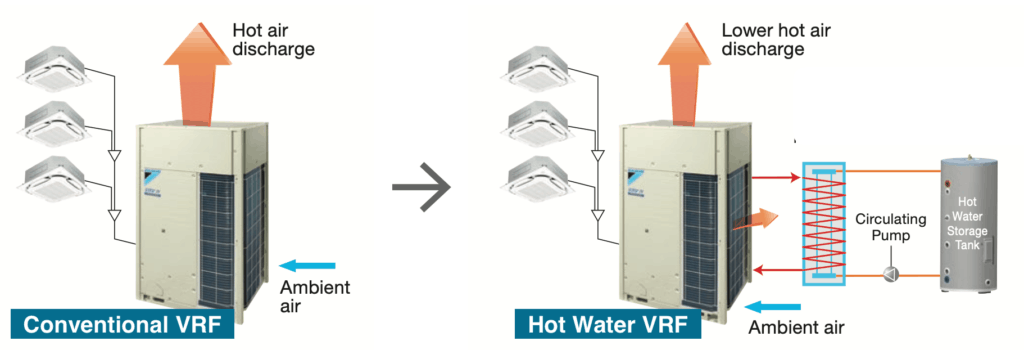
A heat recovery VRF system does exactly the same thing when it comes to the cooling side but, it has an additional function to reuse the absorbed heat energy into useful hot water instead of throwing it away to the surrounding like the conventional VRF system does.
When sizing it correctly, the hot water VRF system can heat the stored water up to 60 degree Celsius where 60 degree Celsius is the common hot water storage temperature.
The heat recovery VRF system is one step higher in energy efficiency than the conventional VRF system. However, the overall cost of ownership is much higher too.
The heat recovery VRF system needs a separate heat exchanger to transfer the heat energy from the VRF outdoor unit to your hot water storage tank.
Yes, you still need a storage tank.
Then, you’ll need a hot water pipeline with a circulation pump and a bunch of valves for the system to work. Moreover, the application must be well suited for the system or else, you’ll be using the backup electric heater a lot more which can yield you a very bad return on investment.
If you are looking for an energy saving hot water system, you can consider using a heat pump system. Heat pump system is essentially the same as your house air conditioner but reverse in the process. It typically 3 times more energy saving than the conventional electric heater.
How Much is the Cost of the VRF System?
With a ballpark figure, the air-cooled VRF system cost about twice as much as the single split system and approximately 20~30% cheaper than the water-cooled chiller system. Nonetheless, it varies greatly based on application and sizes.
What’s the Difference Between the VRF and Multi-Split System?
The VRF system controls the amount of refrigerant flow into each indoor units while the multi-split unit is essentially multiple indoor units sharing a single outdoor unit without refrigerant flow control.
What is a 3 Pipes VRF System?
The outdoor unit of this VRF system connects 3 refrigerant pipes to its indoor unit. With the additional 1 pipe, the indoor unit can deliver both cooling and heating.
What is the Biggest Problem with the VRF System?
The biggest problem with the VRF system is a refrigerant pipe defect. The VRF massive piping network makes it extremely difficult to find pipe defects such as a crack or a tiny hole. A massive amount of refrigerant could be wasted during the repair and it is very costly and time-consuming.
Lastly, consider my HVAC Begin (eBook) if you’re a beginner and you want to have a foundational knowledge in HVAC. But, if you have a year or two of experience, then I would suggest you consider my HVAC Basics (eBook). Nonetheless, I encourage you enroll in my HVAC Beginner Course: 10 Days to Become Competent in HVAC if you want to equipped yourself with a complete set of basic HVAC skills.
HVAC Beginner Course
Learn the most basics and foundational HVAC skills including cooling capacity calculation, equipment selection, duct sizing, pipe sizing, exhaust fan sizing, controls, electrical and more.
If you have anything to add (or ask) about this topic, leave a comment down below!



